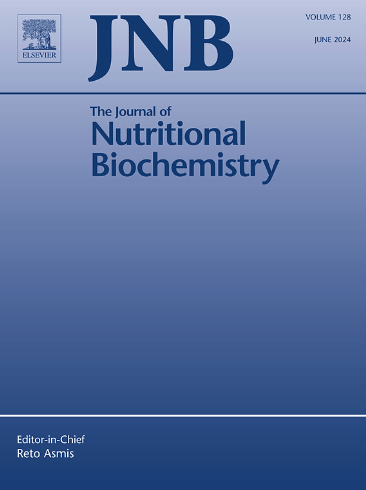乳铁蛋白对小鼠高脂高胆固醇饮食诱导的非酒精性脂肪性肝病的影响。
IF 4.8
2区 医学
Q1 BIOCHEMISTRY & MOLECULAR BIOLOGY
引用次数: 0
摘要
背景与目的:非酒精性脂肪性肝病(NAFLD)是最常见的慢性肝病,代表着日益增长的公共卫生负担。虽然先前的研究表明,乳铁蛋白(LF)减轻了肝脏脂质积累,这是NAFLD的一个标志,但其机制仍然难以捉摸。方法:将雄性C57BL/6J小鼠随机分为对照组(CON)、高脂高胆固醇含巧克力饮食组(HFCCD)和HFCCD+LF组,干预8周。分析肝脏和小肠组织的脂质代谢及其机制。此外,评估肠道菌群组成和短链脂肪酸(SCFA)水平。结果:HFCCD喂养引起肝脏脂肪变性,而LF干预通过减少脂肪酸合成和增加肝脏脂肪分解来改善脂质代谢。在机制上,LF下调了与脂肪生成相关的血清素受体2A (HTR2A)的蛋白表达,上调了肝脏中关键的脂溶基因之一过氧化物酶体增殖因子激活受体α (PPARα)及其下游效应物肉碱棕榈酰转移酶1a (CPT-1A)的蛋白表达。此外,LF增加了与糖脂代谢相关的肠道菌群的相对丰度,如阿德勒克氏菌,降低了促进5- ht的肠道菌群的相对丰度,如梭菌。此外,LF增加了SCFAs水平,这与阿德勒氏菌的相对丰度呈正相关。结论:本研究提示LF干预可缓解hfccd诱导的小鼠NAFLD,这可能与调控HTR2A-PPARa-CPT-1A通路和肠道菌群组成有关。本文章由计算机程序翻译,如有差异,请以英文原文为准。
Effects of lactoferrin on high-fat and high-cholesterol diet-induced non-alcoholic fatty liver disease in mice
Non-alcoholic fatty liver disease (NAFLD) is the most prevalent chronic liver disease, representing a growing public health burden. While previous studies indicated that lactoferrin (LF) alleviates hepatic lipid accumulation, a hallmark of NAFLD, the mechanisms involved are still elusive. Male C57BL/6 J mice were randomly divided into the control (CON), high-fat, high-cholesterol diet containing cholate (HFCCD), and HFCCD+LF groups and treated for 8 weeks' intervention. Liver and small intestine tissues were analyzed to investigate lipid metabolism and underlying mechanisms. Additionally, gut microbiota composition and short-chain fatty acid (SCFA) levels were assessed. HFCCD feeding induced hepatic steatosis, while LF intervention improved lipid metabolism by reducing fatty acid synthesis and increasing lipolysis in the liver. Mechanistically, LF downregulated the protein expression of serotonin receptor 2A (HTR2A), which is related to lipogenesis, and upregulated the protein expression of peroxisome proliferator-activated receptor α (PPARα), which is one of the pivotal lipolytic genes, and its downstream effector, carnitine palmitoyl transferase-1A (CPT-1A), in the liver. Additionally, LF increased the relative abundance of gut microbiota related to glycolipid metabolism, such as Adlercreutzia, and decreased the relative abundance of 5-HT-promoting gut microbiota, such as Clostridia. Furthermore, LF increased the levels of SCFAs, which positively correlated with the relative abundance of Adlercreutzia. Our study suggests that LF intervention alleviates HFCCD-induced NAFLD in mice, which is potentially associated with regulation of the HTR2A-PPARa-CPT-1A pathway and gut microbiota composition.
求助全文
通过发布文献求助,成功后即可免费获取论文全文。
去求助
来源期刊

Journal of Nutritional Biochemistry
医学-生化与分子生物学
CiteScore
9.50
自引率
3.60%
发文量
237
审稿时长
68 days
期刊介绍:
Devoted to advancements in nutritional sciences, The Journal of Nutritional Biochemistry presents experimental nutrition research as it relates to: biochemistry, molecular biology, toxicology, or physiology.
Rigorous reviews by an international editorial board of distinguished scientists ensure publication of the most current and key research being conducted in nutrition at the cellular, animal and human level. In addition to its monthly features of critical reviews and research articles, The Journal of Nutritional Biochemistry also periodically publishes emerging issues, experimental methods, and other types of articles.
 求助内容:
求助内容: 应助结果提醒方式:
应助结果提醒方式:


